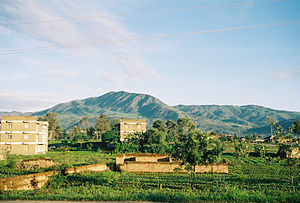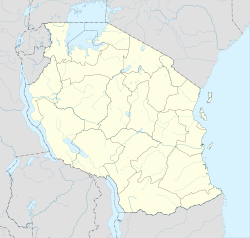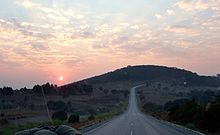- Mbeya
-
Mbeya — City — The mountains surrounding Mbeya Location in Tanzania Coordinates: 08°54′00″S 33°27′00″E / 8.9°S 33.45°E Country  Tanzania
TanzaniaRegion Mbeya Region District Mbeya Urban Incorporated city 1 July 2005 Time zone EAT (UTC+3) Mbeya is a city located in southwest Tanzania, Africa. Mbeya's urban population was 280,000 in 2005. Mbeya is the capital of the surrounding rural Mbeya region (population, with Mbeya, totals approx. 2 million).
Mbeya is the first large urban settlement encountered when travelling overland from the neighbouring nation of Zambia. Mbeya is situated at an altitude of 1,700 meters (5,500 ft), and sprawls through a narrow highland valley surrounded by a bowl of high mountains. The main language is colloquial Swahili, and the English language is extensively taught in schools.
Contents
History
Following the 1905 gold rush, Mbeya was founded as a gold mining town in the 1920s. The TAZARA railway later attracting farming migrants and small entrepreneurs to the area. Mbeya and its district was administered by the British until 1961. Mbeya Region was created in 1961.
Economy and infrastructure
Local government is administered via the Mbeya Urban District authority and a Regional Commissioner.
Services and corrugated iron roofing are seemingly the main business activities, after smallholder agriculture. Local crops include maize, rice, bananas and potatoes. Tanzania has a free market in agricultural produce, and Mbeya transports vast amounts of its maize to other areas of Tanzania. There is also extensive animal husbandry, with dairy cattle predominating. Smallholder agriculture is not standardised; methods vary greatly and are often innovative. High-value export crops are also grown, such as tea and coffee. There is some smallholder cultivation of tobacco. Firewood is collected by women and girls, from the wooded valleys and mountainsides. Bamboo is naturally abundant in the forests, and there are plans to teach local people about this versatile plant and its many uses. Some gold is still mined in the rural Chunya District, by artisan miners.
Since 2004 Mbeya has advanced considerably. A plethora of hotels and guest houses have sprung up in Mbeya, as well as many other banks now offering ATM/VISA services.
There is a large 450-bed hospital in Mbeya. It serves the whole of the Southern Highlands region, although there is a severe shortage of trained medical staff.
There are also number of schools, churches, hotels, a regional police headquarters, and several petrol stations in Mbeya. As well as the usual shops, there is a fixed vegetable and fresh produce marketplace. Mbeya provides a variety of services, including the Apricort Restaurant, Sindi Chinese Restaurant, 'Babu Kubwa' Indian restaurant, Metro Cuisine and internet cafes.
Mbeya has extensive outskirts, with the worst poverty concentrated at the fringes.
Education
Besides a growing number of secondary schools like Meta, Sangu, Loleza, Mbeya day, St Mary's Mbeya, Mbeya has some institutes of higher learning education:
- Teofilo Kisanji University is a young institution of the Moravian Church in Tanzania offering courses in theology,business, arts, sciences and educational studies, as well as training pastors and. Since 2005, it has grown out of the earlier Moravian Theological College. The college is situated at Soweto suburb.
- Mbeya Institute of Science and Technology (MIST) is a public institution offering degrees, advanced diplomas, and ordinary diplomas in various engineering disciplines. MIST was formerly known as Mbeya Technical College (MTC). The College is at Iyunga area. Currently, it is under the process of being transformed into a full University
- Mzumbe University (MU) Mbeya Campus is situated in Forest area next to the Bank of Tanzania. This public University offers bachelor degrees and diplomas in law and business, as well as providing evening programs in postgraduate studies.
- Tanzania Institute of Accountancy (TIA) is another public University, offering advanced diplomas and ordinary diplomas in Accountancy, Procurement, and Material Management. The Institution is situated at the Mafiat area, along the Tanzania-Zambia Highway.
- Agricultural Research Institute (ARI Uyole), with a training college and a large research library. This was previously the Ministry of Agriculture Research and Training Institute (MARTI).
- MARTI-Igurusi is a training college in agricultural sciences, and is similar to the ARI Uyole. Its uniqueness is based on being the only agricultural institution in Tanzania which offers various irrigation courses
- Shukrani International College of Business Management and Administration is an institution operated by The Salvation Army in Tanzania. Located in the Soweto area of Mbeya, it offers diploma courses in Business Administration, Sales and Marketing, Computer Studies, Office Management and Administration.
- VETA Southern Highland Zonal Centre is another vocational training college, situated in the Ilomba area.
- Tumaini University has also opened its centre in Mbeya, at Uzunguni area, which offers various diplomas and certificate courses. The processes are underway in order to open the University College at Uyole
- The University of Arusha has already opened its centre at SOWETO suburb, which offers various courses there.
Geography and climate
Mbeya has a subtropical highland climate (Cwb, according to the Köppen climate classification), with humid summers and dry winters. The general range of temperature is between -6 °C in the highlands and 29 °C on the lowlands. Mbeya's cooler climate can be deceptive in terms of sun exposure - sun screen lotion is recommended when hiking, even in what seems to be overcast weather. The weather from June until October, is dry and cold. The best weather is from December to February, although the heaviest rainfall occurs during the months December to March - it is somewhat warm (relatively speaking).
The area around Mbeya town (especially in Tukuyu) enjoys abundant and reliable rainfall which stimulates abundant agriculture on the rich volcanic soils. Average rainfall per year is around 900mm. The rainy season is from March to May. It is cool in Mbeya much of the time. Sometimes visitors will need warm clothing, such as a sweater or hat, to keep warm.
Because it is in the Southern Hemisphere, winter is June-Oct while summer is from Dec-Feb.
Mbeya Climate chart (explanation) J F M A M J J A S O N D 2022414176241418624141192413302310622742262248426101627136727142052414Average max. and min. temperatures in °C Precipitation totals in mm Source: World Climate Guide Imperial conversion J F M A M J J A S O N D 875576.975577.375574.775551.273500.272450.272430.175460.279500.681552.681578.17557Average max. and min. temperatures in °F Precipitation totals in inches Mountain reserves and wildlife
The area around Mbeya has been called the "Scotland of Africa", and with good reason. The hills are clad in heather and bracken, but botanically they are more closely related to the Fynbos (fine bush) of South Africa’s Western Cape Province than the Highlands of Scotland. The nearest mountain to Mbeya is Loleza Mountain, which rises over and behind the town. Mbeya Peak is visible but some distance away.
Mount Rungwe is the highest mountain in the wider Mbeya region and it dominates the skyline for several kilometers around. It is composed of ten or more dormant volcanic craters and domes. Rising above the small town of Tukuyu, at 2,960m, Rungwe is southern Tanzania's highest peak, and is among the highest in the country after some of the peaks in northern Tanzania such as Mount Kilimanjaro (5,895m) and Mount Meru (4,565). Mount Rungwe is surrounded by the catchments forest reserve that was gazetted in 1949. This forest reserve incorporates montane forest, upper montane forest and montane grassland, with lesser amounts of bushland and heath at the upper elevations, found in low bushes along streams and at the edges of montane forest. The forest is home to a variety of significant forest flora and fauna, including the threatened Abbott's Duiker. The forest is regarded as important bird area, with two species listed as vulnerable. The most notable creatures are Rungwe bush viper and Colobus monkeys.
Also ecologically important are the Poroto Mountains, south-east of Mbeya. In 2005, a completely new species of large monkey was discovered living in the southern highlands to the south-west of Mbeya. The Mbeya region has not yet been closely studied by scientists, and doubtless there are also many new species of plants to be discovered there, and perhaps even new animals.
The Kitulo Plateau, famous for its orchids and display of native flora is now within the designated Kitulo National Park.
Forests in the area, even in the reserves, continue to be encroached upon and degraded. However, there has also been extensive tree and forest planting, which ensures the local firewood supply. There is a small illicit trade in orchid bulbs, which is thought to be endangering the survival of some species.
Rivers
Catchments from the reserve feeds numerous villages and towns from Kiwira to Katumba to Tukuyu and Kandete, and all settlements in between. All streams from the north, west and southwest flow into the Kiwira River. These streams include the Marogala, Sinini, Kipoke, Kilasi and Mulagala. In the southeast is the source of the Mbaka River, with the Suma River feeding into it. In the east the Mrambo and the Mwatisi flow out of the reserve. All of the above rivers flow into Lake Nyasa. The region's rivers are generally clear and fresh, and the area is outside the mosquito zone. Freshwater fish abound in the rivers. Other rivers flow from various sources in a catchment divide at the area called Igoma in Mbeya rural district. Also, Igoma is a dividing watershed for the two river systems, those flowing southward to lake Nyasa and those flowing northward towards the Usangu plains. The rivers flowing norhtwards are Ipatagwa, Mlowo Mwambalizi and other minor ones and are among tributaries of the great Ruaha River which flows into Indian Ocean.
Transport
Mbeya is the location of a regional TAZARA Railway hub.[1]
Tourism
The rains normally start in October and end around May, followed by a dry and cold spell between June and September. Mbeya can be reached by bus services along tarmac roads, or via the TAZARA railway line from the capital (approx. 600-miles, two overnight passenger trains per week). An airport is marked on maps, this grass strip handles quite a number of aircraft weekly including Missionary Aviation Fellowship Flights, AMREF air ambulance and various charter and government planes.
A major airport is under construction about 20 km south west of Mbeya but is not yet functioning for commercial flights.
There are game watching safaris, and also trout fishing in the mountains to the south. There are efforts to widen tourism beyond animal and wild game viewing, which can best be done in Madibila and Rujewa.
Mbeya is the best place in Tanzania for hiking and forest walking; which is aided by the cooler climate, friendly villages and pure clear water in the river catchments. Well-defined hiking trails have been established to enable hikers to reach the elevated areas and bio-diverse highlands, although the trails need to be properly mapped. For self-sufficient hikers, some of the best, and least known trekking in Africa is in the Poroto Mountains around the small town of Tukuyu.
Botanical excursions are also promoted, due to the presence of the natural flower garden at Kitulo.
Recommended lodgings include: the Karibuni Center in Mbeya, the Mbeya Hotel, the Holiday Lodge, the Highlands and the Moravian Youth Hostel for budget travellers. South of Mbeya, signposted off the main road into Zambia, the Utengele Country Resort is a charming country hotel with excellent food and a vibrant pub.
Sports and culture
As for football, the city is represented in the Tanzanian Premier League by Prisons FC; the team is owned by the Tanzanian Prison Service based in Mbeya and the home venue is Sokoine Stadium.
Twin towns - sister cities
References
- ^ "Tanzam Journey". Railways Africa. November 9, 2010. http://www.railwaysafrica.com/blog/2010/11/tanzam-journey/. Retrieved June 21, 2011.
External links
- Accommodation in Mbeya
- Rail timetable details.
- Karibuni Center in Mbeya.
- A tourist diary of a visit to Mbeya.
- Extensive photo gallery of Mbeya, its people and activities in 2001.
- Map of the forest reserves around Mbeya.
- Southern Highlands Conservation Programme is based in Mbeya.
- Detailed 1936 study of the Mbeya region's topography (German only, but English map).
External links
Categories:- Mbeya
- Cities in Tanzania
- Regional capitals in Tanzania
- Mbeya Region
Wikimedia Foundation. 2010.




